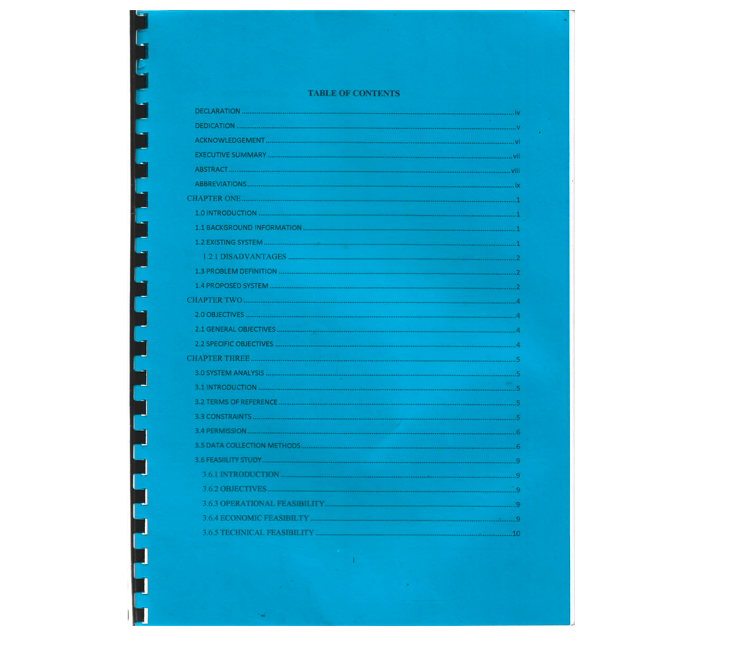Trade project notes outline and the sample in pdf highlighted here. Trade project unit is examinable by Kenya national examination council KNEC to be guided by your respective institution with marks submitted after presentation and is mainly taught in various courses highlighted below;
- Diploma in information communication technology module 3
- Diploma in Electrical and electronic engineering among others.
TRADE PROJECT: This guide will highlight a full guideline on writing the perfect trade project for your course and highlight a pdf example of a fully written Trade project. A good Trade project should have a cover page, declaration, dedication, acknowledgement and abstract each on its own pages. A good cover page should have the title of the research proposal, course code of the candidate, index number, exam series, institution name, supervisors name and the department for example business or ICT department. You may also choose to add references, appendix and questionnaire to your trade project.
CHAPTER ONE
Consists of the following sections;
- 1.0 Introduction of the project area
- 1.1 Background of the study
- 1.2.1 Background
- 1.2.2 Overview of the existing system
- 1.2.3 Overview of the proposed system
- 1.2 Problem statement
- 1.3 objectives
- 1.4.1 Project goal( major objective)
- 1.4.2 General objectives
- 1.4.3 specific objectives
- 1.4 Research questions
- 1.5 Justification
- 1.6 scope of the study
- 1.7 Limitations of the proposed system
- 1.8 Project risk and mitigation
- 1.9 Project schedule
- 1.10 Budget and resources
CHAPTER 2
LITERATURE REVIEW: This consists of what has been done in the area of study; related work to your study and why you are not adopting or accepting their results for your study. Students are advised to use papers that are peer reviewed as they have validated solutions. Google scholar is a valuable tool where you can get up to date works from different scholars. The literature review should not be just a compilation of reproduction of the work of others. It requires the student to examine and comment critically on the literature relevant to the students project area or area of research.
- 2.1 Reviewed similar systems
- 2.2 Tools and methodologies used in reviewed systems
- 2.3 Gaps in the existing systems and proposed solutions
- 2.4 The proposed solutions
CHAPTER 3
METHODOLOGY: The methodology chapter should describe a model or framework under which the system will be developed. It should address at least the following areas;
- The exact techniques used to collect data and facts
- Tools used to analyze the data and processes
- Tools to implement and test the system
- Time schedule and project cost
- State the reasons for choosing the methodology
- Describe the tools that will be used in methodology like flowcharts.
- 3.1 Methodology
- 3.2 Source of data
- 3.3 Data gathering
- 3.3.1 Describe methods of data collection
- 3.3.2 Data collection tools
- 3.4 Resource required
- 3.5 Fact recording
CHAPTER 4
SYSTEM ANALYSIS AND REQUIREMENT MODELLING, SYSTEM DESIGN(FINDINGS, DATA ANALYSIS AND DESIGN)
The chapter should address at least the following areas
- Description on how the current system works using system analysis modelling tools such as flow charts, DFDs, use cases, UML etcetera.
- How the facts and the data gathered including the methods used
- Requirement definitions and modelling of the current system and proposed system
- Requirement definitions and specifications of the project.
- 4.1 Introduction
- 4.2 Objective
- 4.3 Feasibility study
- 4.4 System analysis design tools
- 4.5 System investigation
CHAPTER 5
SYSTEM DESIGN This section should consist of a description of the system design, database design (conceptual, logical and physical) using appropriate modelling tool
- 5.1 Introduction
- 5.2 Objectives
- 5.3 Program design tools
- 5.4 Logical design
- 5.5 Physical design description
5.5 1 Data dictionary 2, File/database design for all tables entries, 3 output screen design for all reports, 4 input screen design, 5 Code design for all record keys, 6 Block diagram/structured/modular chart, 7 process program design/UML, 8 system flowchart, 9 program flowchart and lastly 10 modular program flowchart
TRADE PROJECT FULL SAMPLE (PDF) You can access these and other notes from this PAGE
FREE KNEC PAST PAPERS PDF FORMAT:
- Diploma in ICT module 2 KNEC past papers Free download
- Diploma in ICT module 3 KNEC past papers Free download
- Certificate in ICT module 1 KNEC past papers Free download
- Certificate in ICT module 2 KNEC past papers Free download
- Diploma in Electrical and electronic engineering module 1 KNEC past papers Free download
- Diploma in electrical and electronic engineering module 2 KNEC past papers Free download
- Diploma in Human resource management module 1 KNEC past papers Free download
- Diploma in human resource management module 2 KNEC past papers Free download
- Craft in supply chain management module 1 KNEC past papers Free download
- Diploma in building technology module 1 KNEC PAST papers
- Diploma in building and technology module 2 KNEC past papers
- Diploma in building and technology module 3 KNEC past papers
- Diploma in civil engineering module 1 KNEC PAST PAPERS
- Diploma in civil engineering module 2 KNEC PAST PAPERS
- Diploma in civil engineering module 3 KNEC PAST PAPERS
- Certificate in electrical and electronic engineering module 1 KNEC PAST PAPERS
- Certificate in electrical and electronic engineering module 2 KNEC PAST PAPERS
- Craft in supply chain management module 2 KNEC PAST PAPERS
- Diploma in Quantity survey KNEC past papers
- Certificate in plumbing module 1 KNEC past papers
- Certificate in building and technology module 1 KNEC past papers
- Certificate in building and technology module 2 KNEC past papers
- Diploma in social work and community development module 1 KNEC past papers
- Diploma in social work and community development module 2 KNEC past papers
- Diploma in social work and community development module 3 KNEC past papers
- Diploma in electrical and electronic engineering module 3 KNEC past papers
- Diploma in Human resource management module 3 KNEC past papers
- Diploma in supply chain management module 3 KNEC past papers
- Diploma in supply chain management module 1 KNEC past papers
- Certificate in human resource management module 2 KNEC past papers
- Diploma in supply chain management module 2 KNEC past papers
- Certificate in human resource management module 1 KNEC past papers
- Certificate in food and beverage module 1 KNEC past papers
- Certificate in food and beverage module 2 KNEC past papers
- Diploma in catering and accommodation module 1 KNEC past papers
- Diploma in catering and accommodation module 2 KNEC past papers
- Diploma in catering and accommodation module 3 KNEC past papers
- Diploma in food and beverage module 1 KNEC past papers
- Diploma in food and beverage module 2 KNEC past papers
- Diploma in food and beverage module 3 KNEC past papers
- Diploma in tourism management module 1 KNEC past papers
- Diploma in tourism management module 2 KNEC past papers
- Diploma in tourism management module 3 KNEC past papers
- Certificate in tour guiding and travel operations module 1 KNEC past papers
- Certificate in tour guiding and travel operations module 2 KNEC past papers
- Diploma in business management module 1 KNEC past papers
- Diploma in business management module 2 KNEC past papers
- Diploma in business management module 3 KNEC past papers
- Diploma in sales and marketing module 1 KNEC past papers
- Diploma in sales and marketing module 2 KNEC past papers
- Certificate in business management module 1 KNEC past papers
- Certificate in business management module 2 KNEC past papers
- Certificate in project management module 1 KNEC past papers
- Certificate in project management module 2 KNEC past papers
- Certificate in sales and marketing module 1 KNEC past papers
- Diploma in agriculture module 1 KNEC past papers
- Diploma in agriculture module 2 KNEC past papers
- Diploma in agriculture module 3 KNEC past papers
- Diploma in early childhood development KNEC past papers
- Certificate in early childhood development and education KNEC past papers
COURSE NOTES
- Introduction to ICT and ethics notes PDF
- Communication skills notes PDF
- Entrepreneurship notes PDF
- Economics notes PDF
- Financial accounting notes PDF
- Business law notes PDF
- Research methodology notes PDF guide
- Trade project notes & PDF sample
- Principles and practice of marketing notes PDF
- Microprocessor systems notes PDF
- Management information system MIS notes PDF
- Data communication and networking notes PDF
- Internet based programming IBP notes PDF
- Quantitative methods notes PDF
- Visual basic notes PDF
- Object oriented programming notes PDF
- Database management system notes PDF
- System analysis and design notes PDF
- Quantitative techniques notes PDF
- Principles and practice of management PPM notes PDF

